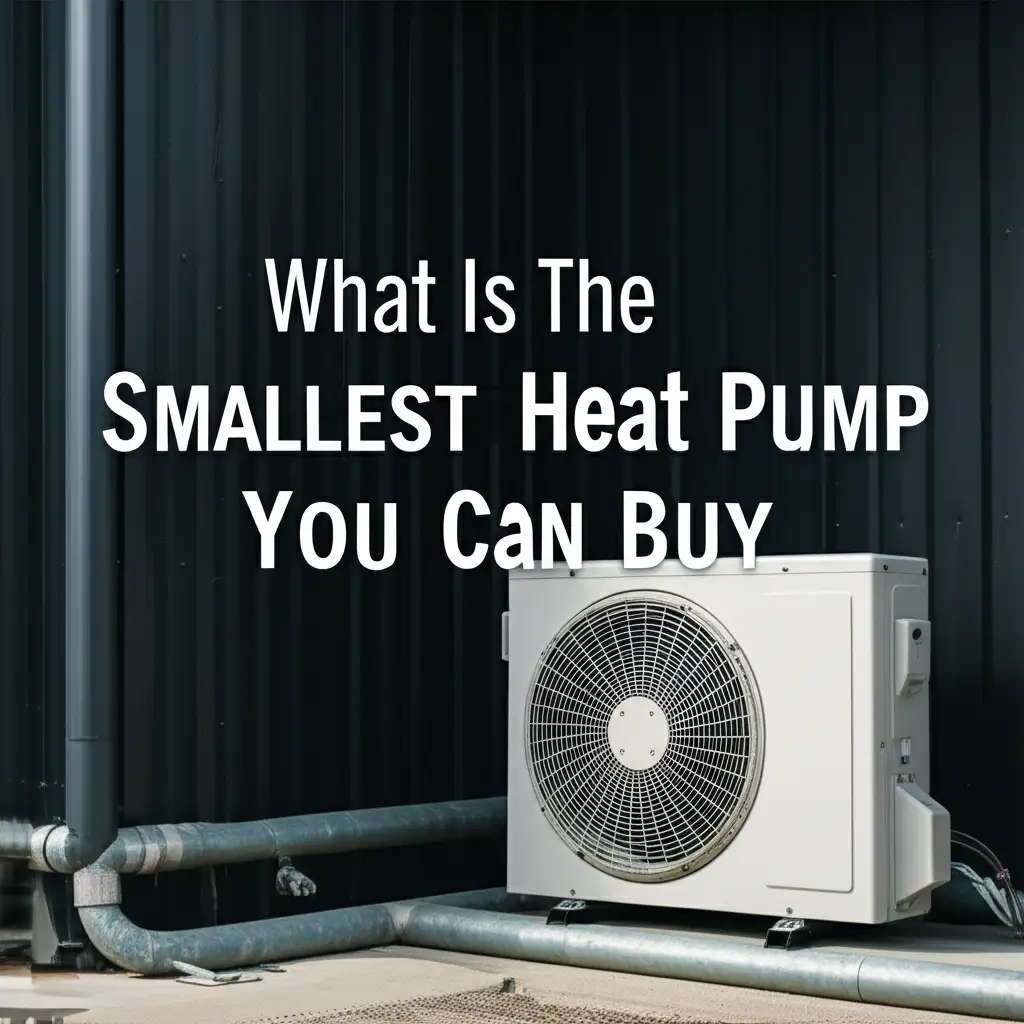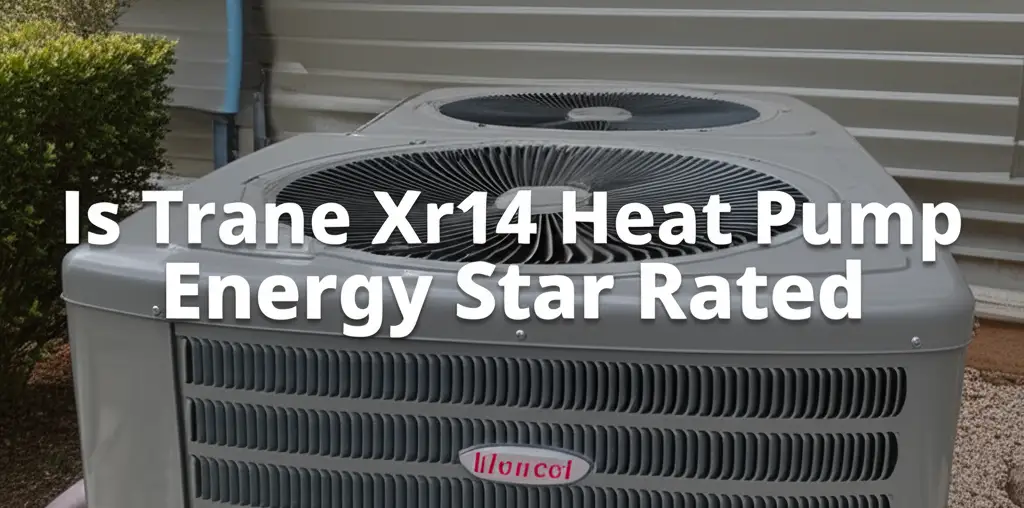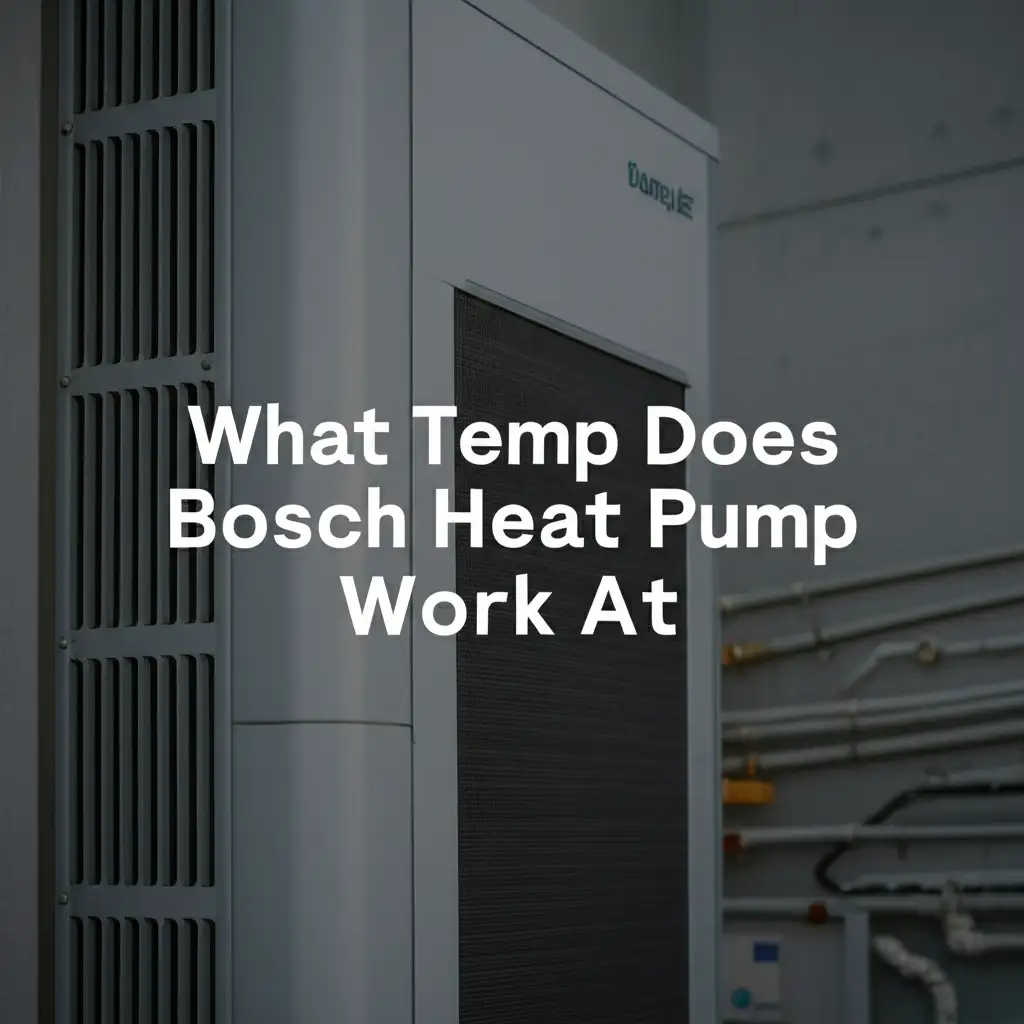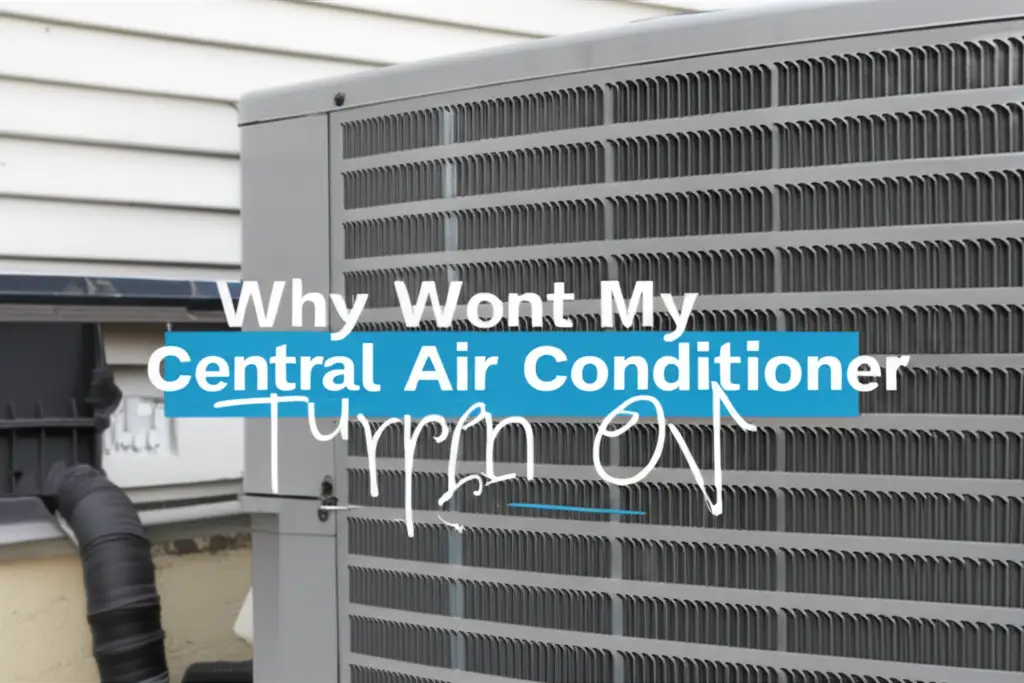· Katria Melrose · HVAC Systems · 18 min read
What Is The Smallest Heat Pump You Can Buy

What Is The Smallest Heat Pump You Can Buy?
Living in a cozy apartment, a tiny home, or perhaps you just need to regulate the temperature in a single room? Finding the right heating and cooling solution for small spaces can be a challenge. You want comfort without sacrificing precious square footage or overspending on energy. This is where small heat pumps come in.
Many people wonder about the limits of compact HVAC technology. They ask, “What is the smallest heat pump you can buy?” I understand this common question, as finding an efficient unit for a limited area is key. This article explores the smallest heat pump options available on the market today. We will discuss various types, their ideal applications, and what factors you should consider before making a purchase. My goal is to help you find the perfect compact heat pump solution for your needs.
Takeaway:
- The smallest heat pumps are typically ductless mini-splits, starting around 6,000 BTUs.
- Portable and window heat pump units also offer compact solutions for specific needs.
- Proper BTU sizing is crucial for efficiency and comfort in small spaces.
- Consider energy efficiency, installation, and noise levels when choosing.
The smallest heat pump you can buy is typically a ductless mini-split system, offering as little as 6,000 BTUs (British Thermal Units) of heating and cooling capacity. These compact units are designed for single rooms or very small areas. Portable heat pumps and window-mounted units also come in extremely small sizes, providing flexible solutions for limited spaces.
Understanding BTU and Heat Pump Sizing for Small Spaces
Before we dive into the specific types of small heat pumps, it is important to understand BTUs. BTU stands for British Thermal Unit. It measures the amount of energy needed to raise the temperature of one pound of water by one degree Fahrenheit. In the context of HVAC, BTU indicates a heat pump’s heating or cooling capacity. A higher BTU rating means more power.
For small spaces, a lower BTU rating is often necessary. Installing a heat pump that is too powerful (oversized) for a room can lead to several problems. An oversized unit will cycle on and off too frequently, which wastes energy. This short-cycling also means the unit does not run long enough to properly dehumidify the air, making the space feel clammy. Conversely, an undersized unit will struggle to maintain the desired temperature, running constantly without achieving comfort. This leads to higher energy bills and an uncomfortable environment.
Matching the heat pump’s BTU capacity to your space is crucial for optimal performance and energy efficiency. Factors like room insulation, window size, ceiling height, and local climate also influence the required BTU. For instance, a well-insulated room in a mild climate will need fewer BTUs than a poorly insulated room in an extreme climate. I always recommend carefully calculating your space’s needs. You can learn more about how to determine the right size for your system by reading our guide on how to tell what size heat pump I have. This ensures your small heat pump operates effectively and efficiently.
The Smallest Heat Pump Types: Mini-Splits and Portables
When you are looking for the absolute smallest heat pump, two main categories come to mind: ductless mini-splits and portable units. Each offers unique advantages for compact spaces. Understanding their differences will help you choose the best fit for your home. These technologies represent the cutting edge in compact climate control solutions.
Ductless Mini-Split Heat Pumps: The Compact Choice
Ductless mini-split heat pumps are often the go-to solution for small spaces requiring both heating and cooling. They consist of two main components: an outdoor compressor/condenser unit and one or more indoor air-handling units. The smallest single-zone mini-split systems are incredibly compact, with indoor units that can be mounted on a wall or even recessed into a ceiling. These units typically start at capacities as low as 6,000 BTUs. Some manufacturers even offer 5,000 BTU models for extremely small applications.
Mini-splits offer several benefits for small areas. They provide targeted heating and cooling, meaning you only condition the specific room you are using. This leads to significant energy savings. Installation does not require extensive ductwork, which is ideal for additions, converted garages, or older homes. They also operate very quietly compared to traditional window units or central systems. The ability to control individual zones makes them highly versatile for apartments, tiny homes, or even a home office. You might be interested to know that does an air source heat pump have to be outside helps clarify their setup. This unique design gives them an edge in versatility and efficiency.
Portable Heat Pumps: A Flexible, Smaller Option
Portable heat pumps offer a highly flexible, though generally less efficient, option for small spaces. These are self-contained units that sit on the floor and can be moved from room to room. They typically have a hose that vents exhaust air (and sometimes draws in fresh air) out a window. Portable units usually range from 8,000 to 14,000 BTUs, but smaller models exist. While they are convenient for temporary use or renters, they come with certain limitations.
Portable heat pumps require proper venting, which means a window or a similar opening must be accessible. They also collect condensate water, which needs regular draining, either manually or via a pump. Their efficiency (EER/SEER) is generally lower than mini-splits. This is because they operate inside the conditioned space and introduce negative pressure, drawing in unconditioned outside air. However, for a quick solution in a small, seldom-used room or as a supplement to an existing system, they can be quite useful. If you’re comparing compact cooling options, you might find our article on what is the smallest size air conditioner you can buy helpful.
Window Heat Pumps: Combining AC and Heat in a Small Package
Window heat pumps are another compact solution, primarily designed for single rooms. These units are similar in appearance to traditional window air conditioners but have a reverse cycle capability, allowing them to provide both heating and cooling. They install directly into a window opening, making them a common choice for apartments or older homes without central HVAC. Their compact size makes them ideal for small spaces.
Window heat pumps typically range from 5,000 to 15,000 BTUs. The smallest models are perfect for bedrooms, home offices, or small living areas. They are generally more affordable upfront than mini-splits and easier for a DIY installation. However, they can be noisier than mini-splits and block a portion of the window. For a concise look at cooling alternatives, check out what is the smallest size air conditioner for window. Despite these drawbacks, they offer a powerful and convenient dual-function solution for compact living.
Ideal Applications for Small Heat Pumps
Small heat pumps excel in a variety of settings where traditional central HVAC systems are impractical or overkill. Their compact size and efficiency make them perfect for targeted climate control. I have seen these units transform uncomfortable spaces into cozy retreats. Let me explain some common scenarios where small heat pumps truly shine.
Tiny Homes and RVs: These living spaces demand ultra-compact and efficient solutions. A mini-split heat pump is often the top choice for tiny homes because it offers powerful heating and cooling in a small footprint. RVs can also benefit from specialized compact units designed for mobile applications. My experience confirms they fit perfectly into these minimalist environments.
Single Rooms and Studio Apartments: For a single bedroom, a small home office, or a studio apartment, a dedicated small heat pump is far more efficient than trying to heat or cool the entire house. A 6,000-9,000 BTU mini-split can perfectly condition such a space, ensuring comfort without running up high energy bills. You only pay to condition the space you actually use. This targeted approach saves money and energy.
Converted Garages and Workshops: Many people convert garages into living spaces, home gyms, or workshops. These areas often lack existing ductwork. A mini-split is an excellent choice here. It provides independent climate control, keeping the space comfortable year-round. This allows you to use the converted space for its intended purpose without temperature extremes.
Basements and Additions: Basements can be notoriously damp and cold. A small heat pump helps dehumidify and heat or cool the space effectively. For new room additions, extending existing ductwork can be costly and disruptive. Installing a dedicated mini-split for the addition is often simpler and more cost-effective. It offers complete climate control independent of the main house.
Sunrooms and Three-Season Porches: These spaces are prone to temperature fluctuations. They can become sweltering in summer and frigid in winter. A small heat pump allows you to extend the usability of these rooms. You can enjoy your sunroom comfortably during more months of the year, regardless of the outside temperature. This makes your investment in the space much more valuable.
In all these applications, small heat pumps provide efficient, tailored comfort. They avoid the high costs and complexity of larger systems. This makes them a smart investment for specific, limited spaces.
Key Factors When Choosing the Smallest Heat Pump
When you are looking to buy the smallest heat pump, it is easy to get overwhelmed by the options. Beyond just size, several important factors should guide your decision. Considering these points ensures you pick a unit that is not only compact but also efficient, reliable, and suitable for your specific needs. I want to help you make an informed choice.
BTU Capacity and Room Size
This is the most critical factor. As I mentioned earlier, matching the BTU capacity to your room size is paramount. An undersized unit will struggle to heat or cool properly. An oversized unit will short-cycle, wasting energy and failing to dehumidify effectively. You should calculate the square footage of the space you want to condition. Then, refer to online BTU calculators or consult with an HVAC professional. Remember to account for factors like ceiling height, insulation quality, window area, and heat sources (e.g., electronics, direct sunlight). Getting this right saves you money and ensures comfort.
Energy Efficiency (SEER, HSPF)
Energy efficiency is vital, especially for a unit you plan to use frequently. Look for SEER (Seasonal Energy Efficiency Ratio) and HSPF (Heating Seasonal Performance Factor) ratings. A higher SEER rating means more efficient cooling. A higher HSPF rating indicates more efficient heating. Both are crucial for heat pumps, as they provide dual functions. Units with higher ratings might have a higher upfront cost. However, they will save you significant money on your energy bills over their lifespan. My personal preference is always for high-efficiency models.
Installation Requirements
The type of small heat pump you choose heavily dictates its installation. Portable units are the easiest; just set them up and vent them out a window. Window units require careful placement and sealing in a window opening. Ductless mini-splits are more involved. While they do not need extensive ductwork, they require a hole drilled through an exterior wall for refrigerant lines and electrical wiring. This usually requires professional installation. You should factor installation costs and complexity into your budget and decision.
Noise Levels
In small spaces, noise can be a significant concern. A noisy heat pump can disrupt sleep or concentration. Mini-splits are generally very quiet, both the indoor and outdoor units. Portable units and window units tend to be louder. Check the decibel (dB) ratings listed in the product specifications. Lower decibel numbers indicate quieter operation. If you plan to install the unit in a bedroom or office, prioritize low noise levels. This greatly improves your daily comfort.
Features and Smart Connectivity
Modern heat pumps come with a range of features that enhance convenience and performance. Look for features like remote control operation, programmable timers, and sleep modes. Some units offer advanced air filtration systems, which are beneficial for allergy sufferers. Smart connectivity, allowing you to control the unit from your smartphone, is increasingly common and very convenient. Dehumidification modes are also helpful, especially in humid climates. Consider which features are most important for your lifestyle.
By carefully evaluating these factors, you can select the smallest heat pump that not only fits your space but also meets your performance expectations and budget. Making a thoughtful choice now will lead to lasting comfort and efficiency.
Installation and Maintenance for Small Heat Pumps
Once you have chosen the smallest heat pump for your needs, proper installation and regular maintenance become crucial. These steps ensure your unit operates efficiently, provides consistent comfort, and lasts for many years. Ignoring these aspects can lead to performance issues and higher energy bills. I want to guide you through these essential processes.
Professional vs. DIY Installation
The complexity of installation varies significantly depending on the type of small heat pump.
- Portable Heat Pumps: These are typically plug-and-play. You just need to position the unit and vent the exhaust hose out a window. This is a straightforward DIY task.
- Window Heat Pumps: Installing a window unit involves lifting it into the window frame and securing it with brackets and sealing materials. This can be a DIY project, but it requires careful attention to sealing to prevent air leaks and ensure stability. For larger or heavier units, two people might be needed.
- Ductless Mini-Split Heat Pumps: This is where professional installation becomes almost mandatory. Mini-splits involve electrical wiring, refrigerant line connections, and properly evacuating the lines. These tasks require specialized tools, knowledge of HVAC systems, and often specific certifications. Incorrect installation can lead to refrigerant leaks, poor performance, and even system damage. While some “DIY-friendly” mini-split kits exist, I strongly recommend hiring a licensed HVAC technician for traditional mini-split installations. A professional ensures the unit is installed safely and performs optimally.
Maintaining Your Compact Heat Pump
Regular maintenance is the key to extending the life of your small heat pump and maintaining its efficiency.
- Filter Cleaning/Replacement: This is the most important and easiest task. Air filters become clogged with dust and debris, restricting airflow and reducing efficiency. For most units, you should clean or replace the filters monthly or every few weeks during heavy use. Clean filters ensure good air quality and system performance.
- Coil Cleaning: Over time, the indoor and outdoor coils can accumulate dirt and grime. Dirty coils hinder heat transfer, forcing the unit to work harder. The indoor evaporator coil should be checked periodically and gently cleaned with a soft brush or coil cleaner if dusty. The outdoor condenser coil needs more frequent cleaning, especially if it is exposed to dirt, leaves, or pet hair. You can gently rinse it with a garden hose. Our article on how to clean heat pump coils provides detailed steps.
- Drainage Line Check: Heat pumps produce condensation during cooling (and sometimes heating). This water drains away through a condensate line. Ensure this line is free of clogs from mold or algae. A clogged drain line can cause water leaks and damage.
- Outdoor Unit Clearance: For mini-splits, ensure the outdoor unit has clear space around it. Do not block it with plants, debris, or snow. Good airflow is essential for efficient operation. In winter, also consider how to prevent the unit from freezing. Our guide on how to keep heat pump from freezing in winter offers practical advice.
- Professional Check-ups: Even with regular DIY maintenance, an annual professional check-up is beneficial. Technicians can inspect refrigerant levels, electrical connections, and overall system health. They can identify and fix minor issues before they become major problems.
By prioritizing both proper installation and consistent maintenance, you ensure your smallest heat pump provides reliable and efficient comfort for years to come.
Top Brands and Models for Small Heat Pumps
When searching for the smallest heat pump, you will encounter a variety of reputable brands known for their compact and efficient models. These companies offer solutions specifically designed for smaller spaces, often focusing on mini-split technology due to its efficiency and versatility. My research indicates these brands consistently deliver quality.
Ductless Mini-Split Brands:
- Mitsubishi Electric: Widely regarded as a premium brand, Mitsubishi offers incredibly quiet and efficient mini-split systems, including very small BTU units. Their M-Series and P-Series lines have models starting at 6,000 BTU, making them ideal for single rooms or small apartments. They are known for their reliability and advanced features. You might wonder if a Daikin unit would keep turning off and on, if so, our article on why does my Daikin heat pump keep turning off offers specific brand insights.
- Daikin: Another global leader in HVAC, Daikin also produces high-quality mini-splits. Their systems are known for their robust performance and energy efficiency. Daikin offers models in the 6,000 to 9,000 BTU range suitable for small applications. They often incorporate advanced inverter technology for precise temperature control and quiet operation.
- LG: LG offers aesthetically pleasing and feature-rich mini-split units. Their Art Cool series, for example, combines sleek design with efficient heating and cooling. LG also has compact models starting at 6,000 BTU, often with smart features like Wi-Fi connectivity.
- Gree: As one of the largest HVAC manufacturers globally, Gree offers a wide range of mini-splits, including competitive small BTU options. They provide a good balance of performance and affordability. Gree units are known for their reliable operation.
- Pioneer/Senville: These brands are popular for their “DIY-friendly” mini-split kits, which can be a more budget-conscious option for those comfortable with the installation process (though professional hook-up is still recommended for refrigerant lines). They offer 9,000 BTU and sometimes 6,000 BTU units that are accessible to a broader market.
Specific Small BTU Examples (Mini-Splits):
- Mitsubishi MSZ-GL06NA: This is a 6,000 BTU single-zone mini-split. It is incredibly efficient (high SEER/HSPF) and very quiet, perfect for a bedroom or small office.
- Daikin 6,000 BTU Aurora Series: Designed for cold climates, these units offer strong heating performance even in freezing temperatures, alongside efficient cooling.
- LG LS090HV4: A 9,000 BTU model that provides excellent heating and cooling for slightly larger small rooms or studio apartments, often with smart features.
- Pioneer WYS009GMFI17RL: This 9,000 BTU unit is a popular choice for its balance of performance and value, often found in DIY kits.
Portable and Window Unit Brands:
- LG, Whynter, Honeywell, Black+Decker: These brands frequently offer the smallest portable heat pumps, usually starting around 8,000-10,000 BTUs. They are convenient for temporary use.
- Frigidaire, GE, LG, Midea: These are common brands for window heat pump units. You can find models as small as 5,000-6,000 BTUs that provide both heating and cooling functions.
When considering a brand, look at warranty information, customer reviews, and local service availability. My advice is always to research specific models that fit your BTU needs and preferred features. You want a unit that will perform reliably for your small space.
Cost Considerations for Small Heat Pumps
Understanding the cost of a small heat pump involves more than just the purchase price. You need to factor in installation, operational costs, and potential long-term savings. I want to give you a clear picture of the financial commitment involved. This helps you budget effectively and make a smart investment.
Unit Cost Range
The initial purchase price of a small heat pump varies significantly by type, brand, and BTU capacity.
- Portable Heat Pumps: These are generally the most affordable upfront, ranging from $300 to $800. Their compact size and plug-and-play nature contribute to this lower cost.
- Window Heat Pumps: Similar to portables in price, window units typically cost between $350 and $900. The price depends on features and BTU.
- Ductless Mini-Split Heat Pumps: These represent a larger investment but offer superior efficiency and performance. A single-zone mini-split system (outdoor unit + one indoor unit) typically costs between $800 and $2,500 for the equipment alone. Premium brands or models with advanced features will be at the higher end of this range.
The specific BTU rating (e.g., 6,000 BTU vs. 9,000 BTU) will also influence the price within each category. My experience shows that while some DIY mini-split kits are available for less, professional-grade systems command a higher initial cost.
Installation Costs
Installation is a significant cost factor, especially for mini-splits.
- Portable and Window Units: For these types, DIY installation is common, so installation costs can be $0. If you hire a handyman for a window unit, expect to pay $100-$300.
- Ductless Mini-Split Heat Pumps: Professional installation for a single-zone mini-split typically ranges from $800 to $2,500, or even more depending on the complexity of the job, local labor rates, and whether new electrical circuits are needed. This cost includes the labor, refrigerant, line sets, and sometimes even the unit itself if purchased through the installer. My strong recommendation is to get multiple quotes from licensed HVAC professionals.
Total cost for a professionally installed mini-split can therefore range from $1,600 to $5,000+. This makes them a more substantial investment, but they offer long-term value.
Operating Costs (Energy Savings)
One of the biggest advantages of heat pumps, even the smallest ones, is their energy efficiency. Unlike traditional furnaces that burn fuel or electric resistance heaters that convert electricity directly to heat, heat pumps move
- smallest heat pump
- mini-split heat pump
- compact heating
- portable AC heat
- tiny home HVAC
- small space climate control





